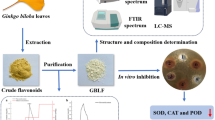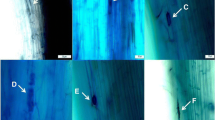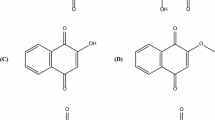Abstract
A flavonoid decomposition product that is present in peanut (Arachis hypogaea) shells, 5,7-dihydroxychromone (DHC), was found to inhibit the radial growth of cultures of the soil pathogenic fungiRhizoctonia solani andSclerotium rolfsii with I50 (the concentrations of DHC required to inhibit growth 50%) values of 18 and 26µM, respectively. Radicle elongation of velvetleaf, corn, peanut, and wheat was inhibited by DHC with I50 values of 30, 50, 65 and 200µM, respectively. DHC had no effect on the growth ofBradyrhizobium sp. at 10µM in medium containing low (1.0 g/liter) mannitol as the carbon source, although the related flavones luteolin and chrysin each promoted bacterial growth at 10µM 48 hr after inoculation. When tested in high (10.0 g/liter) mannitol medium, DHC initially inhibited growth ofBradyrhizobium sp., but 120 hr after inoculation the growth of all treatments were similar. These results suggest a role for DHC released from peanut shells in suppressing pathogenic fungal infection and competing plant growth but not forBradyrhizobium growth promotion.
Similar content being viewed by others
References
Daigle, D.J., Ory, R.L., andBranch, W.D. 1985. The presence of 5,7-dihydroxyisoflavone in peanuts by high performance liquid chromatography analyses.Peanut Sci. 1260–62.
DeLucca, A.J., II, Palmgren, M.S., andDaigle, D.J. 1987. Depression of aflatoxin production by flavonoid-type compounds from peanut shells.Phytopathology 771560–1563.
Harborne, J.B. 1982. Introduction to Ecological Biochemistry, 2nd ed. Academic Press, New York. 278 pp.
Hartwig, U.E., Maxwell, C.A., Joseph, C.M., andPhillips, D.A. 1990. Chrysoeriol and luteolin released from alfalfa seeds inducenod genes inRhizobium meliloti.Plant Physiol. 92116–122.
Hartwig, U.E., Joseph, C.M., andPhillips, D.A. 1991. Flavonoids released naturally from alfalfa seeds enhance growth rate ofRhizobium meliloti.Plant Physiol. 95797–803.
Jong, S.C., andGantt, M.J. 1987. Page 415, in American Type Culture Collection Catalogue of Fungi/Yeasts. American Type Culture Collection, Rockville, Maryland.
Lane, G.A., Sutherland, O.R.W., andSkipp, R.A. 1987. Isoflavonoids as insect feeding deterrents and antifungal components from root ofLupinus angustifolius.J. Chem. Ecol. 13771–783.
Lynn, D.G., andChang, M. 1990. Phenolic signals in cohabitation: Implications for plant development.Annu. Rev. Plant Physiol. Plant Mol. Biol. 41497–526.
Maxwell, C.A., Hartwig, U.E., Joseph, C.M., andPhillips, D.M. 1989. A chalcone and two related flavonoids released from alfalfa roots induce nod genes ofRhizobium meliloti.Plant Physiol. 91842–847.
Paszkowski, W.J., andKremer, R.J. 1988. Biological activity and tentative identification of flavonoid components in velvetleaf (Abutilon theophrasti Medik.) seed coats.J. Chem. Ecol. 141573–1582.
Pendse, R., Rama Rao, A.V., andVenkataraman, K. 1973, 5,7-dihydroxychromone fromArachis hypogaea shells.Phytochemistry 122033–2034.
Peters, N.K., andLong, S.R. 1988. Alfalfa root exudates and compounds which promote or inhibit induction ofRhizobium meliloti modulation genes.Plant Physiol. 88396–400.
Puolin, M.J., Bel-Rhlid, R., Piché, Y., andChênevert, R. 1993. Flavonoids released by carrot (Daucus carota) seedlings stimulate hyphal development of vesicular-arbuscular mycorrhizal fungi in the presence of optimal CO2 enrichment.J. Chem. Ecol. 192317–2327.
Pratt, D.E., andMiller, E.E. 1984. A flavonoid antioxidant in spanish peanuts.J. Am. Oil Chem. Soc. 611064–1067.
Rivera-Vargas, L.I., Schmitthenner, A.F., andGraham, T.L. 1993. Soybean flavonoid effects on and metabolism byPhytophthora sojae.Phytochemistry 32851–857.
Sharon, A., Ghirlando, R., andGressel, J. 1992. Isolation, purification, and identification of 2-(p-hydroxyphenoxy)-5,7-dihydroxychromone: a fungal-induced phytoalexin fromCassia obtusifolia.Plant Physiol. 98303–308.
Siqueira, J.O., Nair, M.G., Hammerschmidt, R., andSafir, G.R. 1991. Significance of phenolic compounds in plant-soil-microbial systems.Crit. Rev. Plant Sci. 1063–121.
Spencer, G.F. 1991. A convenient synthesis of 5,7-dihydroxychromone.OPPI Briefs 23390–392.
Spencer, G.F., andTjarks, L.W. 1985. Germination inhibition by 5,7-dihydroxychromone, a flavanoid decomposition product.J. Plant Growth Regul. 4177–180.
Turner, R.B., Lindsey, D.L., Davis, D.D., andBishop, R.D. 1975. Isolation and identification of 5,7-dimethoxyisoflavone, an inhibitor ofAspergillus flavus from peanuts.Mycopathologia 5739–40.
Weston, L.A., Burke, B.A., andPutnam, A.R. 1987. Isolation, characterization and activity of phytotoxic compounds from quackgrass [Agropyron repens (L.)Beauv.].J. Chem. Ecol. 13403–421.
Author information
Authors and Affiliations
Additional information
Mention of firms or products does not imply endorsement by the U.S. Department of Agriculture over other firms or products not mentioned.
Rights and permissions
About this article
Cite this article
Vaughn, S.F. Phytotoxic and antimicrobial activity of 5,7-dihydroxychromone from peanut shells. J Chem Ecol 21, 107–115 (1995). https://doi.org/10.1007/BF02036645
Received:
Accepted:
Issue Date:
DOI: https://doi.org/10.1007/BF02036645




